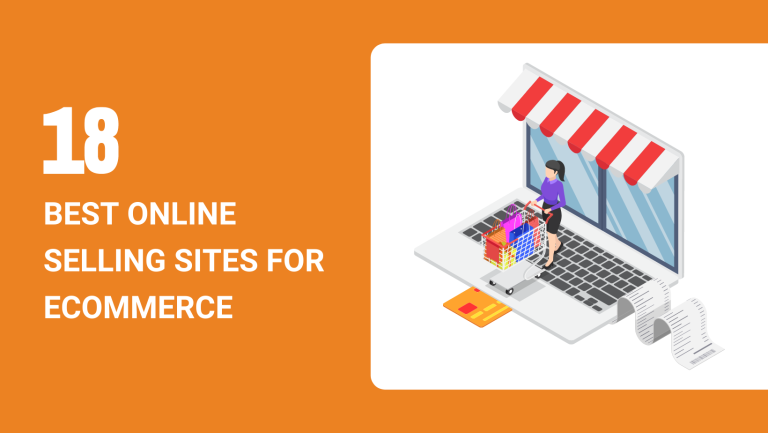Ecommerce is booming, and selling online has never been more promising.
With global ecommerce revenue expected to grow at an annual rate of 8.02% between 2025 and 2029, reaching a projected market volume of $5.89 trillion by 2029.
The numbers make it clear that the opportunities for online sellers are only expanding.
Of course, competition is fierce, and finding the right platform to sell your products is a key factor in success.
But with the right approach, selling online can open up endless opportunities for growth.
In this guide, we’ll explore the top online selling sites and the benefits of ecommerce to help you make an informed decision.
Whether you’re just starting out or looking to expand, this list will point you in the right direction.
Let’s dive in.
Building Your Own Store
While online marketplaces offer convenience, building your own store gives you complete control over your brand, pricing, and customer relationships.
Instead of paying marketplace fees or following third-party rules, you can create a unique shopping experience tailored to your audience.
Shopify is one of the most popular platforms for setting up an online store, offering an easy-to-use interface, customizable themes, and built-in tools to help you manage orders, payments, and marketing.
If you’re considering Shopify for your business, check out our in-depth guides on Shopify dropshipping and how to find Shopify stores in your niche for valuable insights.
Want to learn more? Explore Shopify’s history and our Shopify dropshipping 101 guide to get started.
Top 18 Online Selling Sites
The following online platforms are some of the most popular ones. They’re trusted by shoppers and offer some of the best fees and terms to both online sellers and buyers.
To know where you can sell your products, check out the sites below.
1) eBay
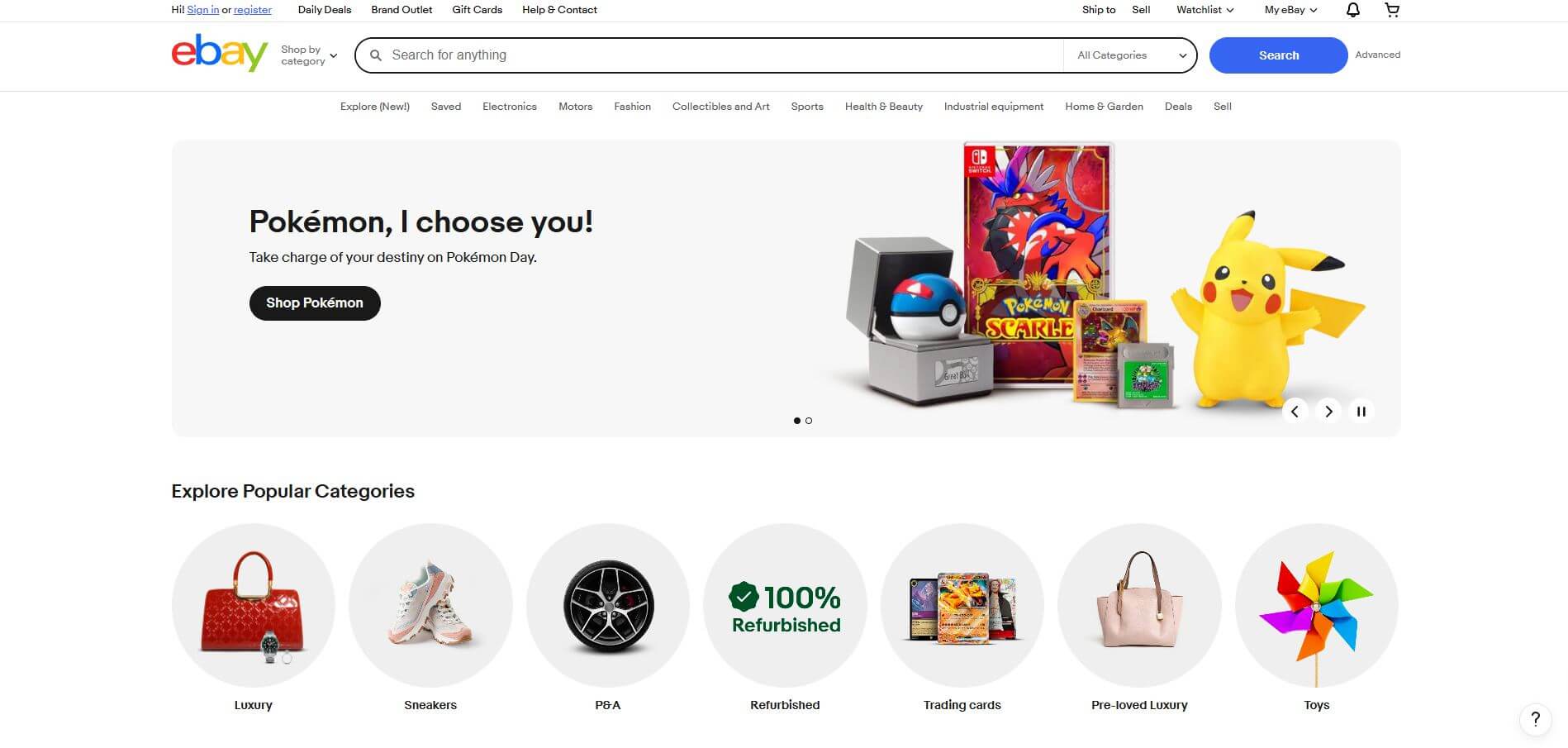
eBay deserves to be a popular online selling website because it’s the original one. Established in 1995, eBay was then known as AuctionWeb up until the name change in 1997.
The website receives more than 1 billion visits per month from 190 countries and territories.
A probable reason why the website is so popular is that people can sell anything they want. From typical shoes and clothing to weird stuff, you can find everything here.
You have two listing options:
- Fixed Price Listing – fixed price for every buyer
- Auction Listing – different buyers bid for your product
However, as a seller, you need to consider the different fees the site charges.
For starters, you get charged a non-refundable listing fee. You also have to pay an insertion fee when you list the same item in a different category. Lastly, a final value fee is charged as a percentage of the total sale amount.
So, if you’re considering selling expensive items, better calculate your profit margin ahead.
Don’t worry though, eBay’s audience is huge. You can sell your products to people in different parts of the world—given that you optimize and market them well.
Platform Fees
eBay charges several fees that sellers need to consider:
- Insertion Fee – Business sellers with a basic account get 250 free listings per month; additional listings cost $0.35 each.
- Final Value Fee – A percentage of the total sale, including shipping, typically 3% to 15%, with most categories around 13.25%. Recent increases have raised some category fees by up to 0.35%.
Best For
Sellers looking for a massive global audience and the ability to sell both new and used items through fixed-price or auction-style listings.
2) Amazon

Amazon dominates global eCommerce, with over 8000 products sold per minute and billions in annual sales!
Since trust is an essential aspect of online selling, Amazon easily grew its customer base. People consistently order from the platform because Amazon is known to screen its sellers and their products, removing fake items.
You don’t have to worry about receiving fake products. If you do, you can check out the return and refund policies, and easily leave a review.
Amazon Prime also happens to be a convenient option for shoppers in a rush. In selected areas, items can be shipped and delivered within a day. Talk about speedy deliveries, right?
Apart from these features, shoppers can easily browse through a variety of product categories, too. Simply utilize their search bar or select a category you want to shop in.
Platform Fees
- Individual Plan – No monthly fee, but sellers pay $0.99 per item sold.
- Professional Plan – $39.99 per month, plus referral and fulfillment fees. This plan includes advertising tools, placement advantages, and bulk inventory management.
- Referral Fees – Typically 8% to 15% per sale, varying by category.
Best For
Businesses looking to scale with global reach, fulfillment services, and strong brand credibility.
3) Ruby Lane
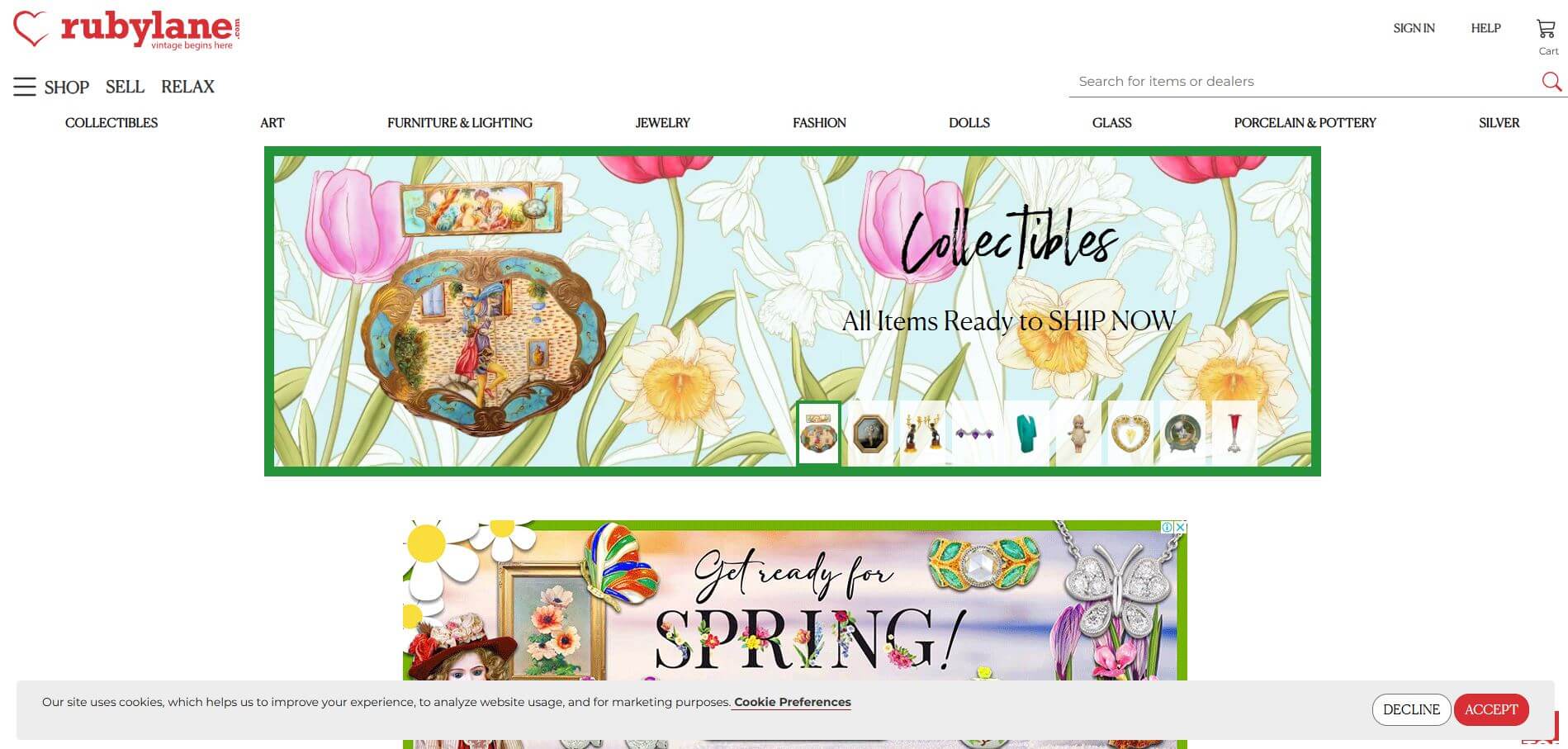
Ruby Lane was created in 1998 when Tom Johnson combined his passion for antiques and collectibles with his experience in the high-tech background.
Quite different from eBay and Amazon, Ruby Lane is focused on everything vintage and artsy. You can find art, jewelry, dolls, glass, porcelain, pottery, and silver on this website.
This online selling site is ideal for business owners who wish to market to vintage enthusiasts. The website itself is already known for its niche, making it easier for sellers to reach their target audience.
Fair warning though, don’t try to sell electronics, tools, or anything other than the usual ones you find on this website.
Platform Fees
- Maintenance Fee – $25 per month, but waived if you add at least 15 new items within the month. New shops also get their first month free.
- Service Fee – 9.9% per order, capped at $250, excluding sales tax.
Best For
Sellers focused on vintage, antiques, and collectibles who want direct access to a niche, engaged audience.
4) Bonanza
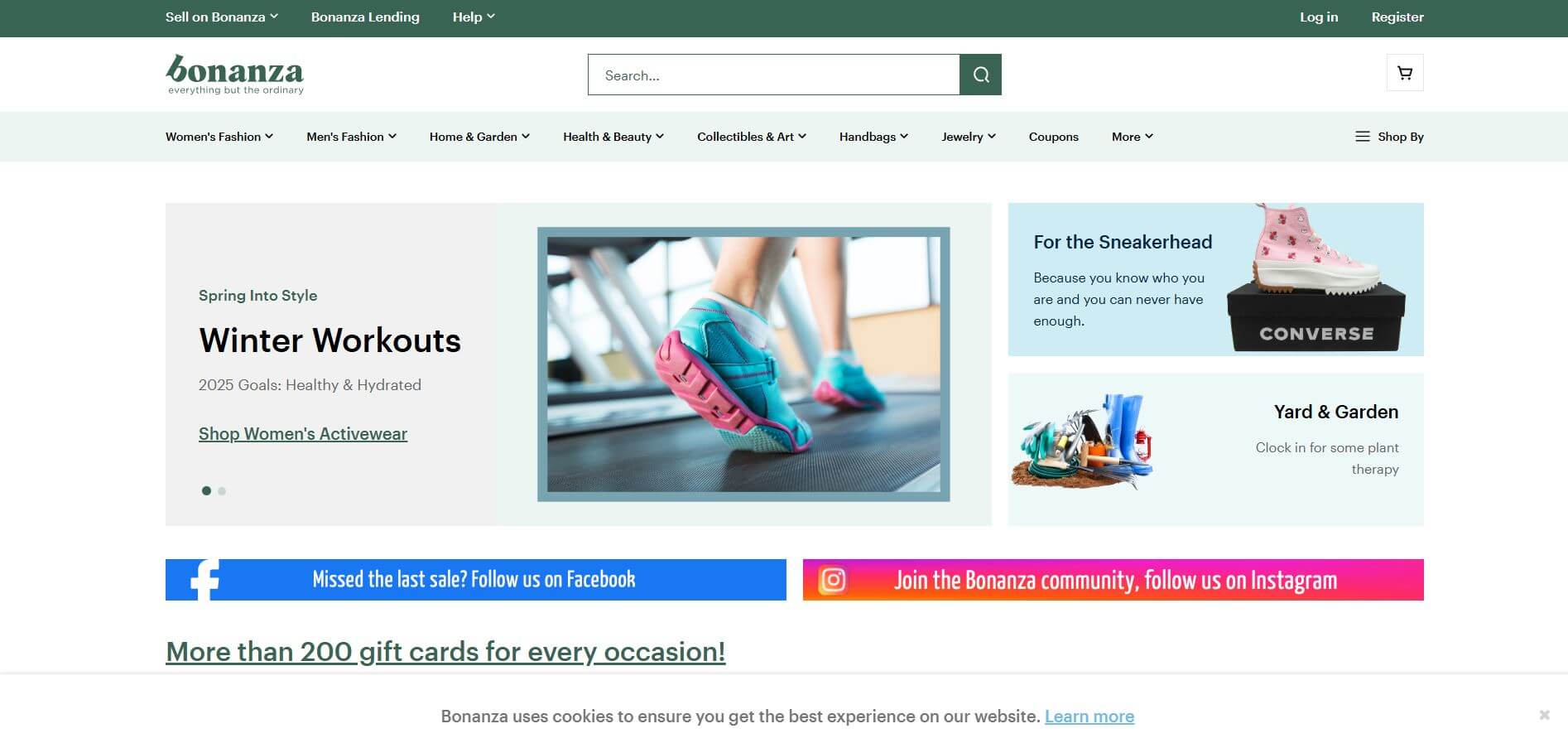
Bonanza is a growing alternative to eBay, known for its seller-friendly approach and low fees. Since its launch in 2007, it has earned recognition for its customer service, ranking first in communication and seller satisfaction in the EcommerceBytes Sellers Choice Awards in 2021.
Unlike many marketplaces, Bonanza does not charge listing or monthly account fees, making it an attractive option for small business owners.
Sellers only pay a fee when they make a sale, and Bonanza even covers initial advertising costs until the first sale is made.
While Bonanza doesn’t have the same volume of branded products as Amazon or eBay, it’s a strong choice for selling handmade, vintage, or niche items.
It also integrates seamlessly with Shopify, allowing sellers to manage their Bonanza listings from their Shopify store.
Platform Fees
- Account Setup Fee – One-time $14.99 non-refundable fee for new sellers.
- Transaction Fee – $0.25 per sale for sellers without a membership.
- Final Value Fee (FVF) – Based on the Final Offer Value (FOV) (item price + shipping exceeding $10).
Best For
Sellers looking for a low-cost marketplace to sell handmade, vintage, or niche products.
5) Flippa
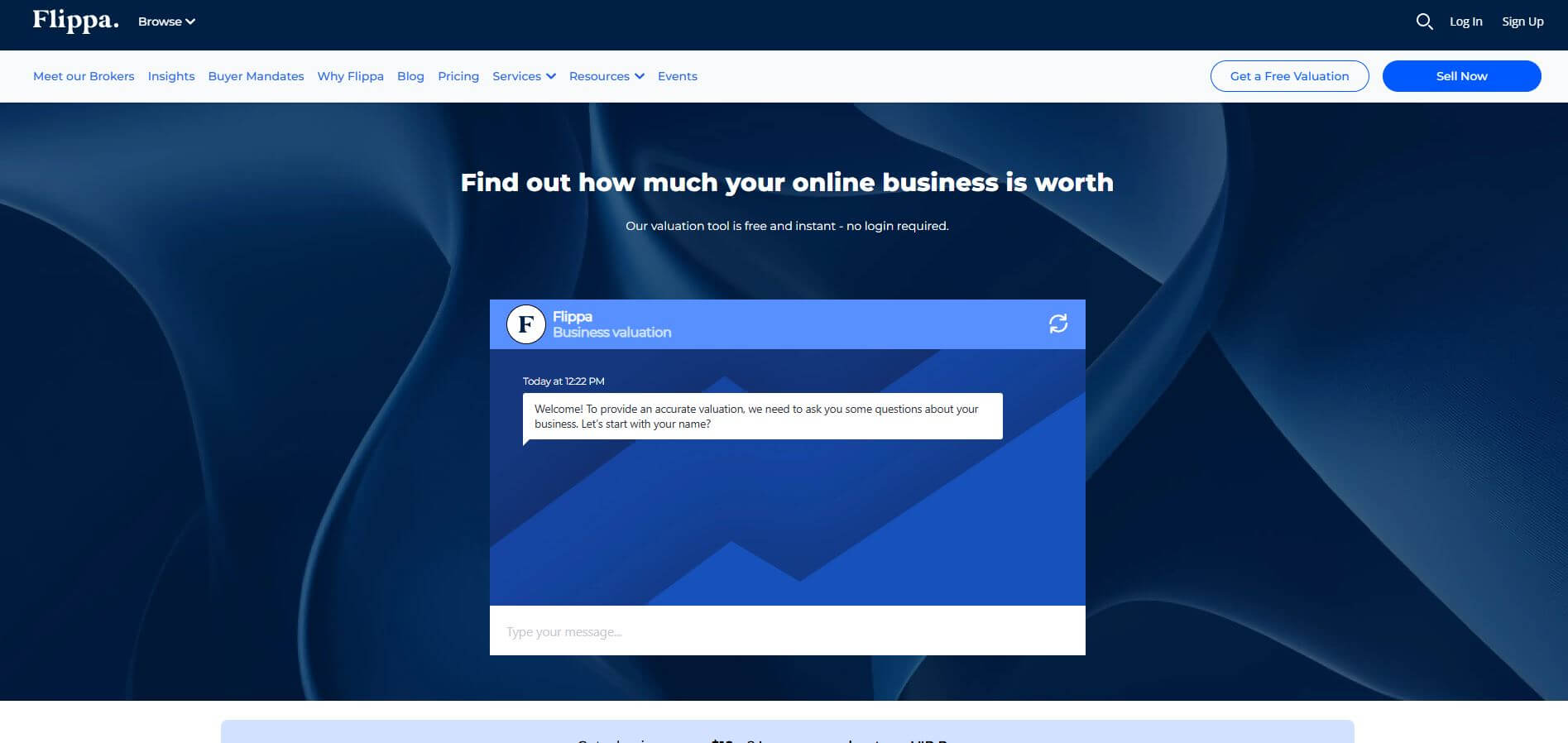
Flippa is a leading marketplace for buying and selling digital assets, including e-commerce stores, blogs, SaaS companies, mobile applications, and social media accounts.
Founded in 2009, it has facilitated the sale of over 300,000 digital assets worldwide.
Flippa offers a free valuation tool, listing promotions, and detailed analytics reports, making it a top choice for businesses looking to monetize their virtual products.
Platform Fees
Listing Fees:
- $10 for domains
- $15 for apps and starter websites
- $49 for established websites and online businesses
Success Fees (Based on Sale Value):
- 10% for sales up to $50,000
- 7.5% for sales between $50,001 – $100,000
- 5% for sales over $100,000
- 15% if sold through Flippa’s partner broker
Best For
Entrepreneurs and business owners looking to sell or acquire digital assets with an active marketplace of verified buyers.
6) Craigslist
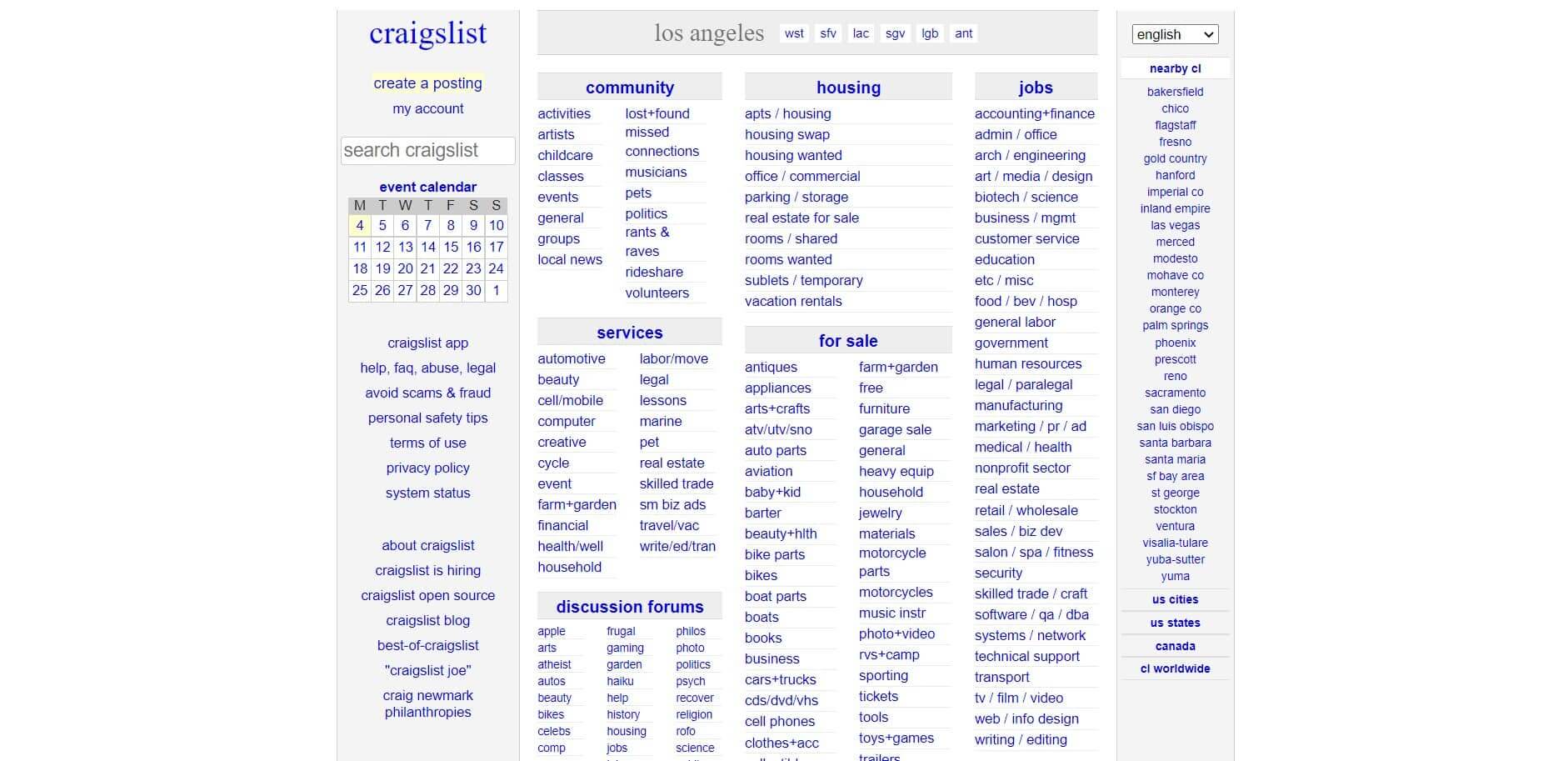
Craigslist is one of the oldest and most recognized online marketplaces for buying and selling locally.
Launched in 1995 by Craig Newmark as a simple email list for San Francisco events, it has since expanded into 700+ local markets across different cities.
Unlike modern eCommerce platforms, Craigslist operates as a basic classified ads website, allowing users to post items for sale with minimal restrictions.
Platform Fees
- Free listings for most categories
- Fees apply for certain listings, such as job postings and dealer vehicle sales (varies by location)
Best For
Sellers looking for a free, local-focused marketplace to sell anything from second-hand goods to event tickets without platform supervision.
7) Etsy
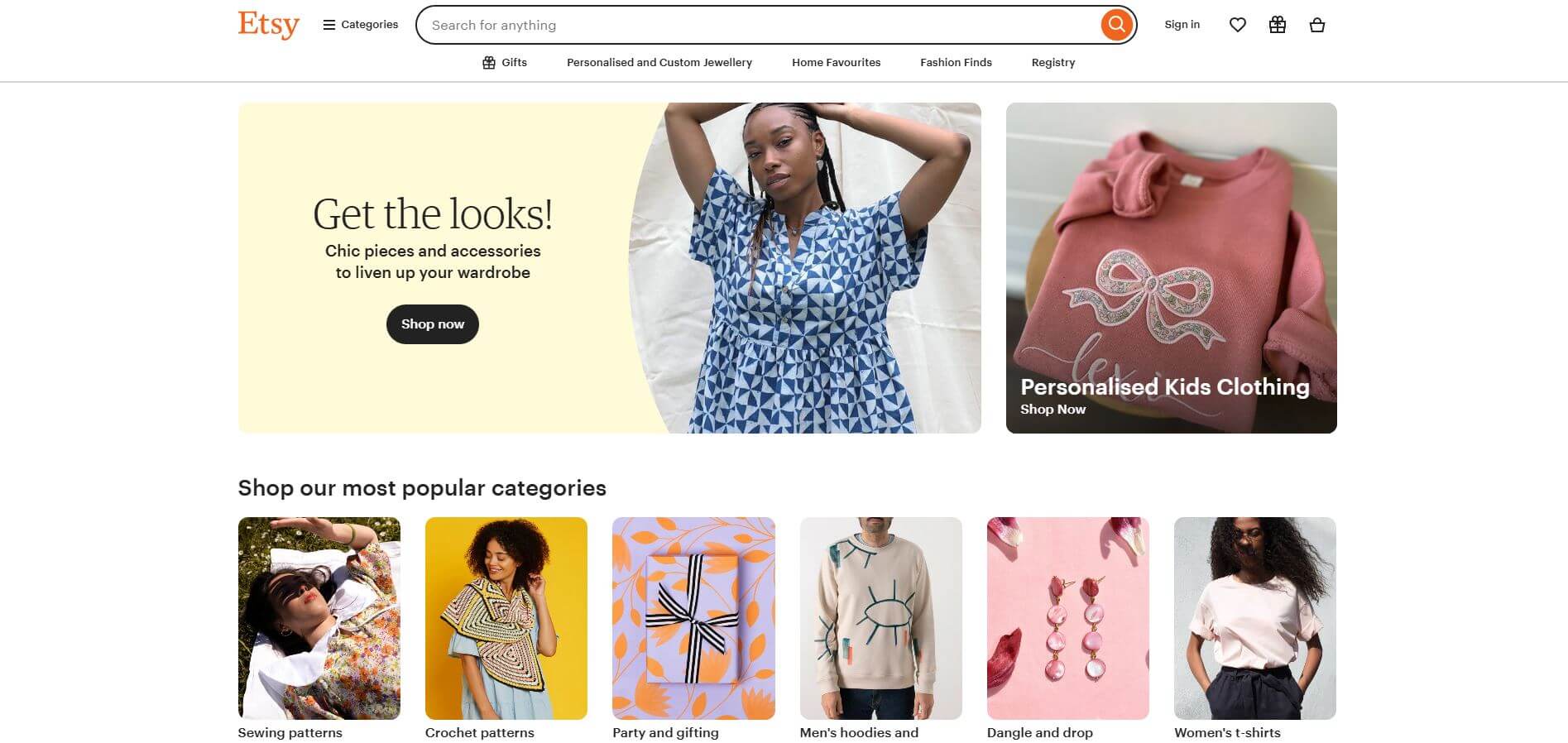
Are you a seller of handmade crafts and vintage items? Well, Etsy deserves to be a part of your options.
Etsy is widely known as the website for these product categories. Ever since it was launched in 2005, shoppers have always gone to Etsy first to find unique items not sold on mainstream markets.
400 million buyers visit Etsy each month. So, if you’re worried about whether someone will notice your product or not, just think about the odds.
Granted, you do your part in advertising and optimizing your product listing.
Platform Fees
Etsy charges several types of fees:
- Listing Fee: $0.20 per listing, valid for four months or until the item sells.
- Transaction Fee: 6.5% of the total sale price, including shipping and gift wrapping.
- Payment Processing Fee: 3% + $0.25 per transaction for Etsy Payments.
- Optional Fees: Advertising fees can range from 12% to 15% of the sale price if ads contribute to the sale. Etsy Plus subscription is $10 per month for additional features.
Best For
Etsy is best for sellers specializing in handmade, vintage, or unique items who want to reach a dedicated audience of buyers interested in these niche products.
8) Swappa
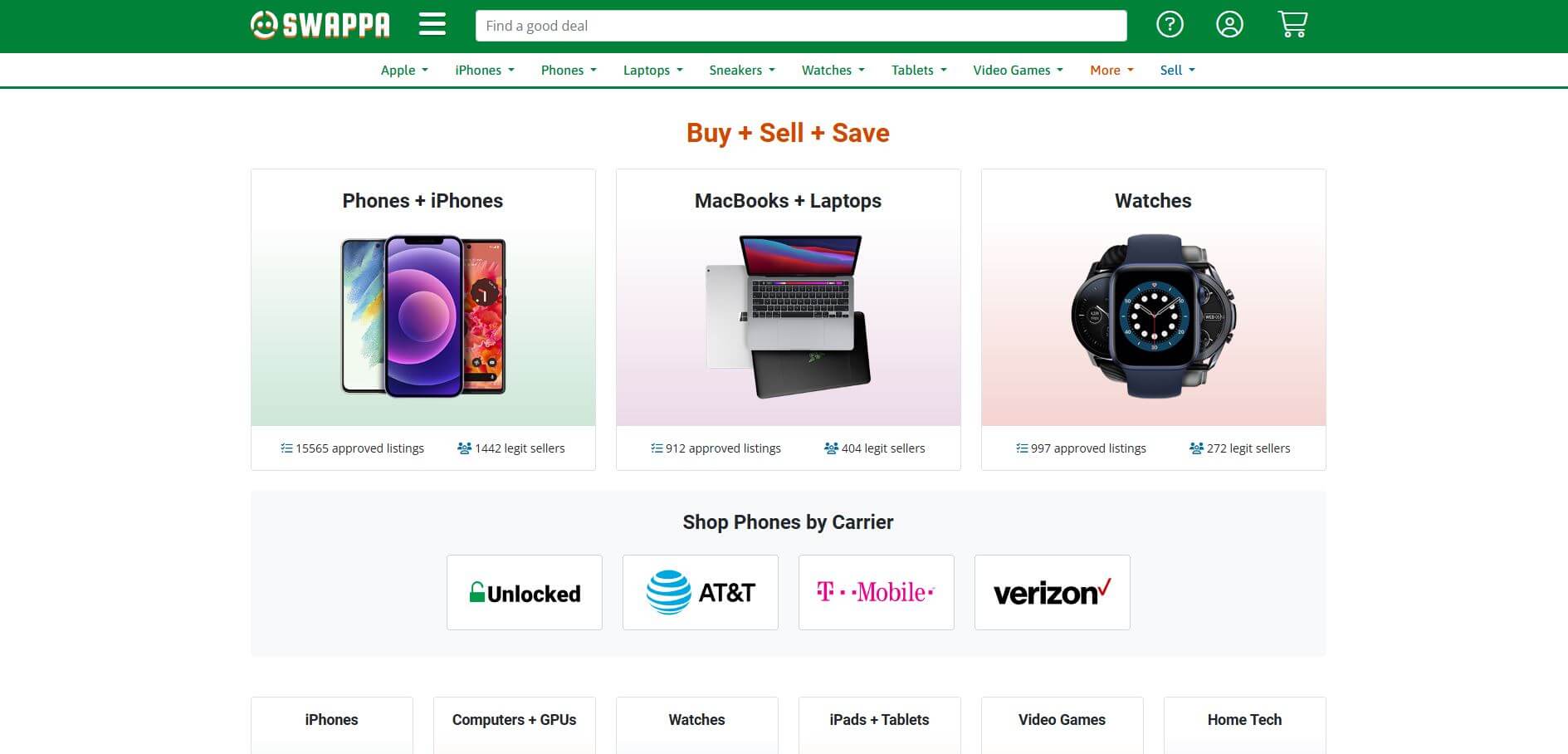
Swappa is a marketplace designed for people who want to buy and sell electronic items. For the most part, it’s a place to let go of old tech you no longer need.
Here, you can see watches, phones, cameras, home tech, and many more tech items.
Of course, given the nature of the items, Swappa has been committed to keeping its website scam-free. They thoroughly review products, requiring sellers to send verification photos and device ownership.
IMEI checks will be done on iPhones to ensure they’re not stolen, and ESN checks will be done on other smartphones and gadgets. With those in place, you know the products are still fully-functional.
Although you can choose to sell your item globally, you can still opt to target nearby markets.
Platform Fees
- Listing Fee – Free to list, but sellers cover shipping costs.
- Transaction Fees – Fees are calculated based on the item’s price at the time of listing.
- Featured Listing – $5 flat fee to boost visibility.
- Payment Processing – All transactions go through PayPal, meaning sellers will cover PayPal’s processing fees.
Best For
People looking to sell used electronics in a secure marketplace with verified listings.
9) Nextdoor
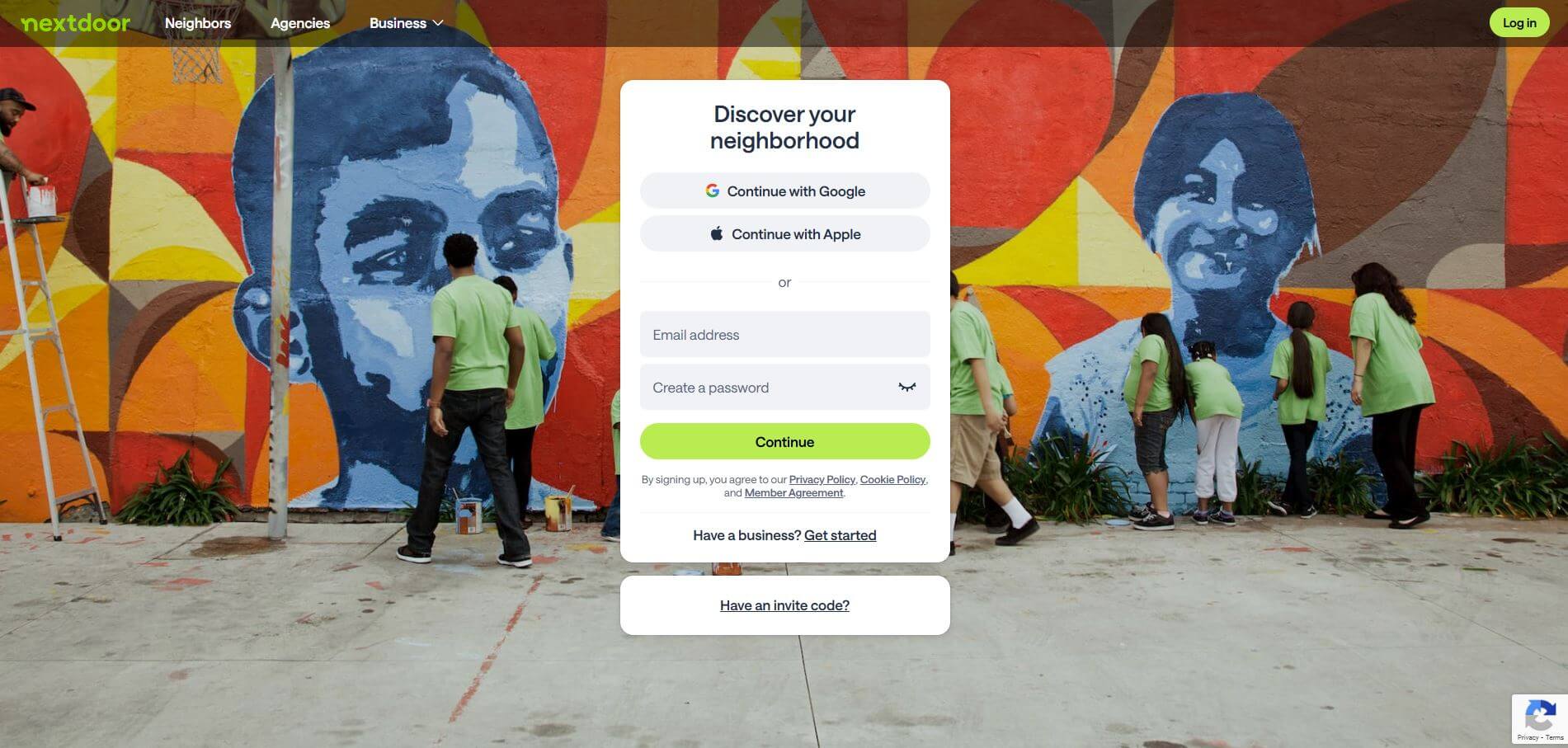
Nextdoor is a social media platform that connects neighbors and local communities, allowing users to share information, buy and sell items, and engage in discussions about local events and issues.
It serves as a community hub where users can post about items for sale or free, making it a great option for those looking for a local, informal marketplace experience.
Nextdoor requires users to verify their address to ensure that interactions remain within the local community, enhancing trust and security.
Platform Fees
Nextdoor does not charge any fees for posting or selling items. The platform is free to use, and users can list items without incurring any costs.
However, users are responsible for coordinating with buyers directly to arrange transactions and deliveries.
Best For
Nextdoor is ideal for sellers who prefer a casual, community-driven approach to selling locally, without the hassle of listing fees or marketplace commissions.
10) Handshake
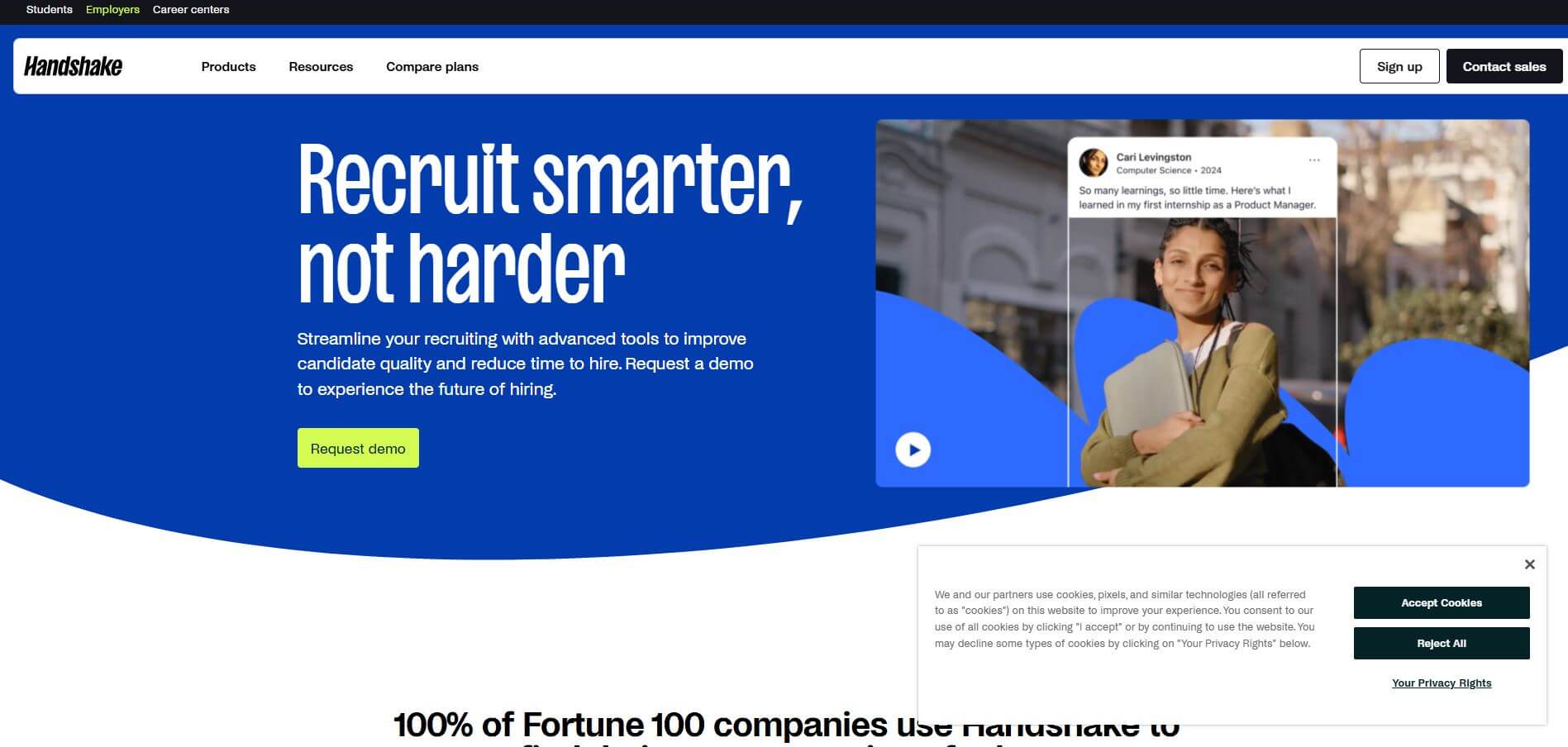
Handshake is a B2B wholesale marketplace developed by Shopify, designed to connect manufacturers and retailers.
It offers a curated platform where suppliers can showcase their products to a targeted audience of qualified retailers.
Handshake integrates seamlessly with Shopify, allowing sellers to manage inventory, track sales, and fulfill orders efficiently.
The platform is ideal for small manufacturers looking to expand their customer base beyond their current e-commerce channels.
Platform Fees
Handshake does not charge listing fees or commissions on sales. It is a fee-free marketplace for sellers, allowing them to retain 100% of their sales revenue.
However, Handshake is a paid add-on for Shopify stores, with costs varying based on the number of users and features chosen.
Best For
Handshake is an excellent choice for U.S.-based wholesalers who already use Shopify and want a fee-free way to expand their reach to retailers.
11) Facebook Marketplace
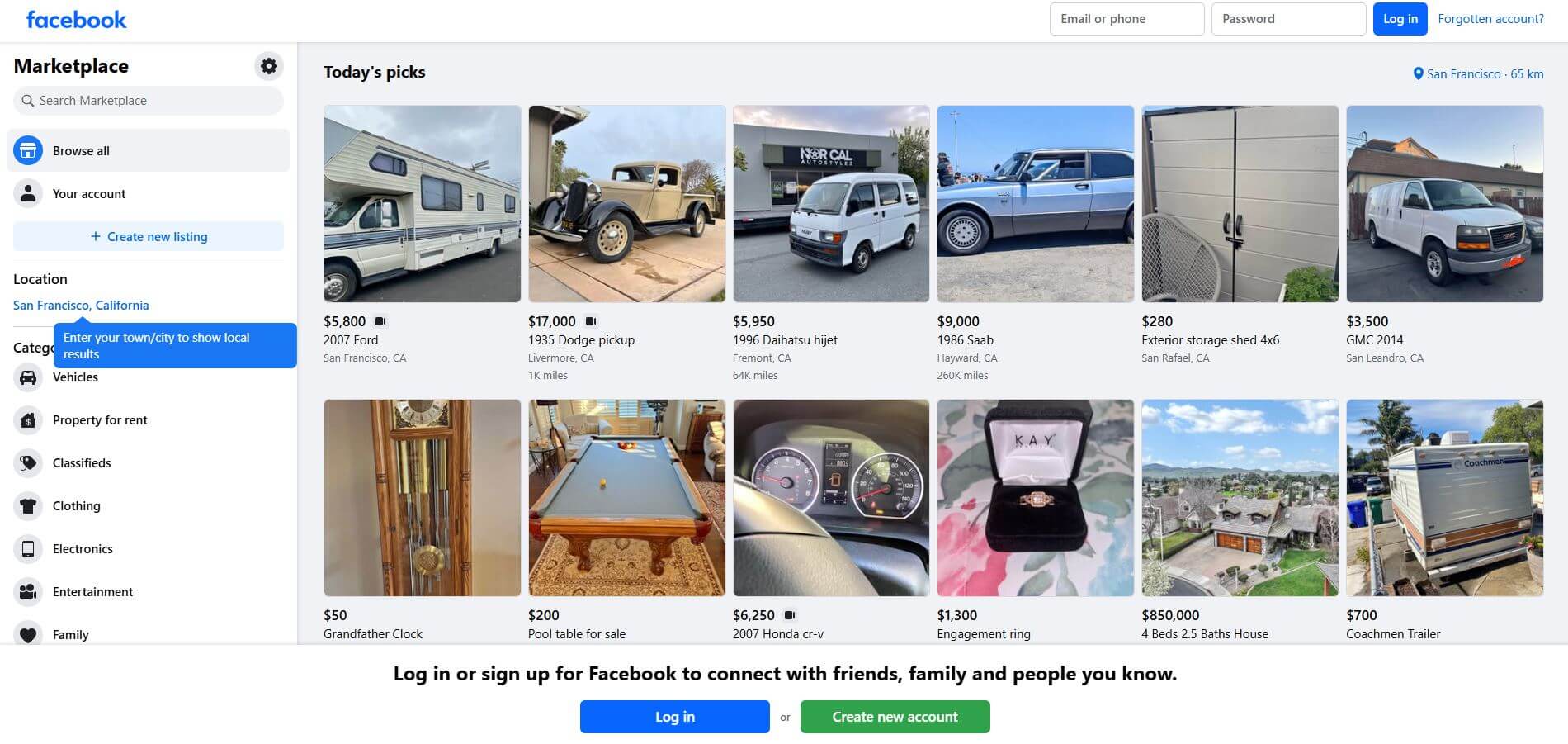
Facebook Marketplace allows users to buy and sell items without leaving the platform. It offers a convenient way to find local buyers and sellers, with search filters for location, categories, and recent listings.
Sellers benefit from a vast audience and a simple listing process, though they must follow Facebook’s selling guidelines.
However, Facebook takes a hands-off approach, meaning transactions are managed directly between buyers and sellers.
To support eCommerce businesses, Facebook has also integrated with platforms like Shopify for streamlined inventory and advertising.
Platform Fees
Free to list and sell items. However, if you sell an item for more than $8, Facebook charges a 5% fee on the sale price, or $0.40 for items priced below $8.
Best For
Individuals and small businesses looking to sell locally without platform fees.
12) Newegg
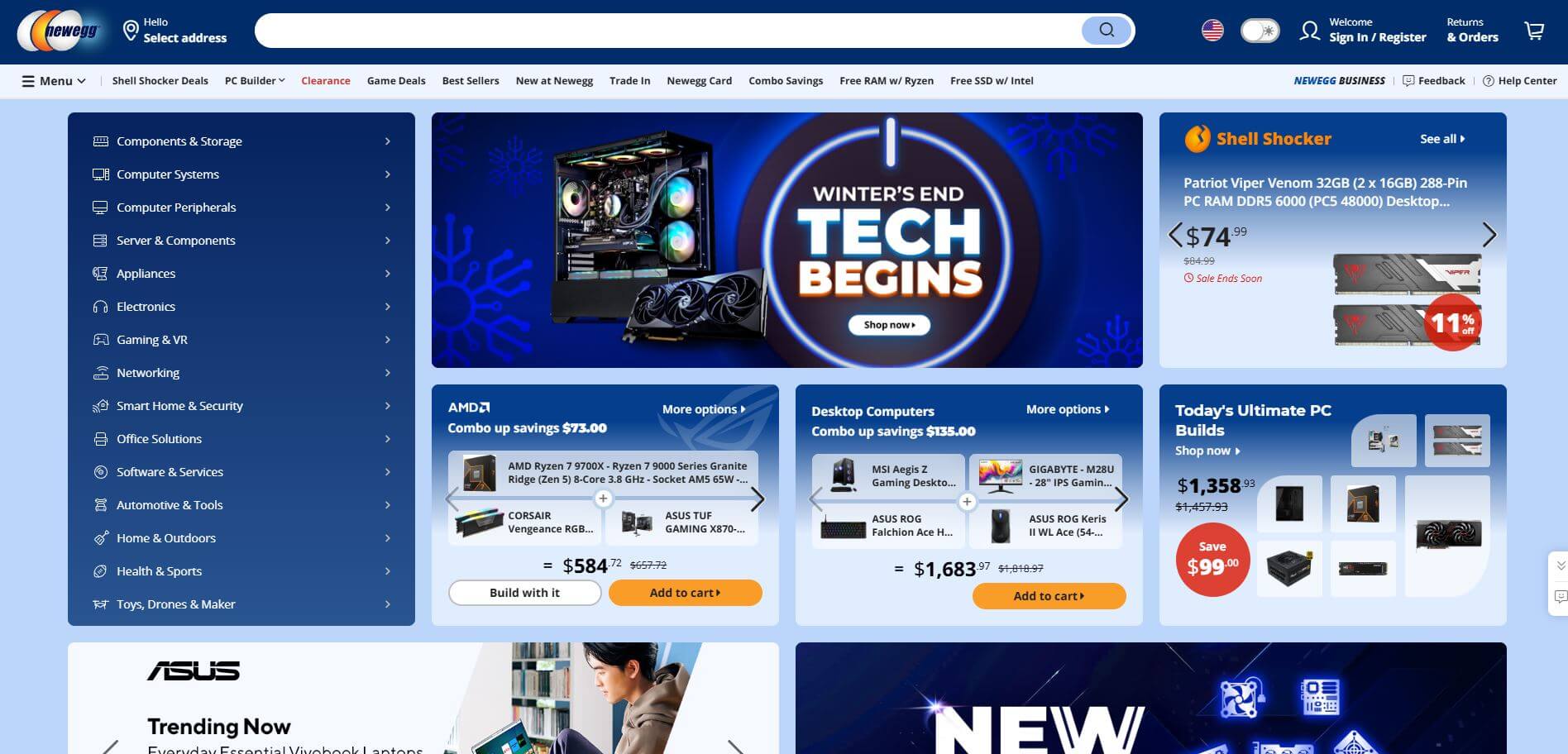
Newegg, founded in 2001, is a leading marketplace for tech-related products, originally specializing in PC components.
Based in California, it serves over 50 countries through its distribution facilities across North America.
The platform attracts a tech-savvy audience, primarily aged 18 to 35, making it ideal for sellers targeting this demographic.
Newegg offers promotional tools like daily emails, seller programs, and merchandising features to help businesses maximize sales.
Platform Fees
Commission rates range from 8% to 15%, depending on the product category. Optional membership plans start at $29.95 for additional benefits.
Best For
Sellers of tech-related products looking to reach a highly engaged, niche audience.
13) Mercado Libre
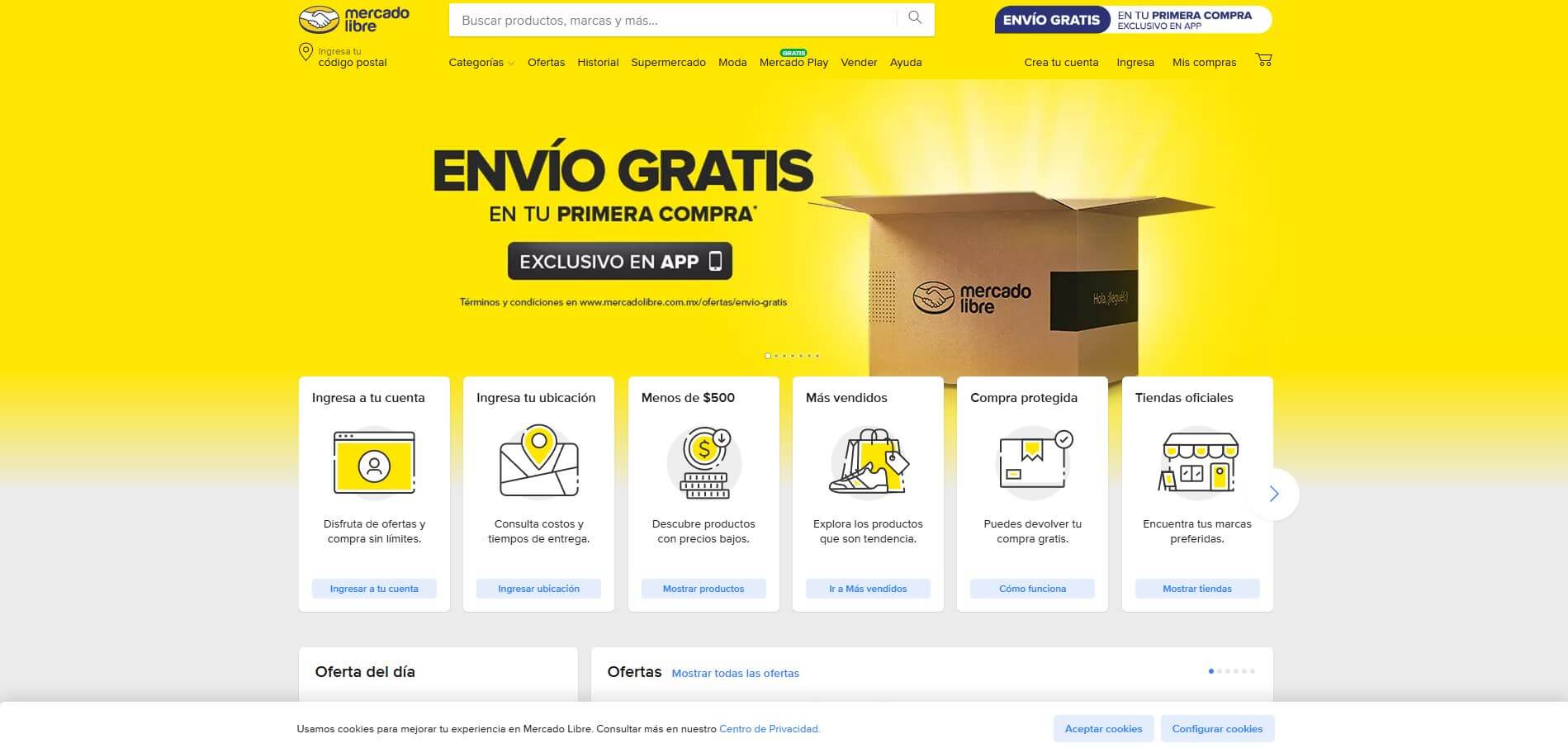
Mercado Libre dominates the Latin American eCommerce market, operating in over 18 countries, including Mexico and Argentina.
Founded in 1999, the platform now has millions of active users. It supports 20 main product categories and offers various fulfillment options, including dropshipping and fulfillment by Mercado Libre.
Sellers benefit from a wide audience without fixed monthly costs, only paying commissions on sales.
The platform also provides six secure payment solutions, including QR payments, prepaid cards, and credit options to enhance customer spending power.
Platform Fees
No fixed monthly costs; commission rates apply per sale.
Best For
Sellers targeting the Latin American market with a wide range of product categories.
14) Chairish
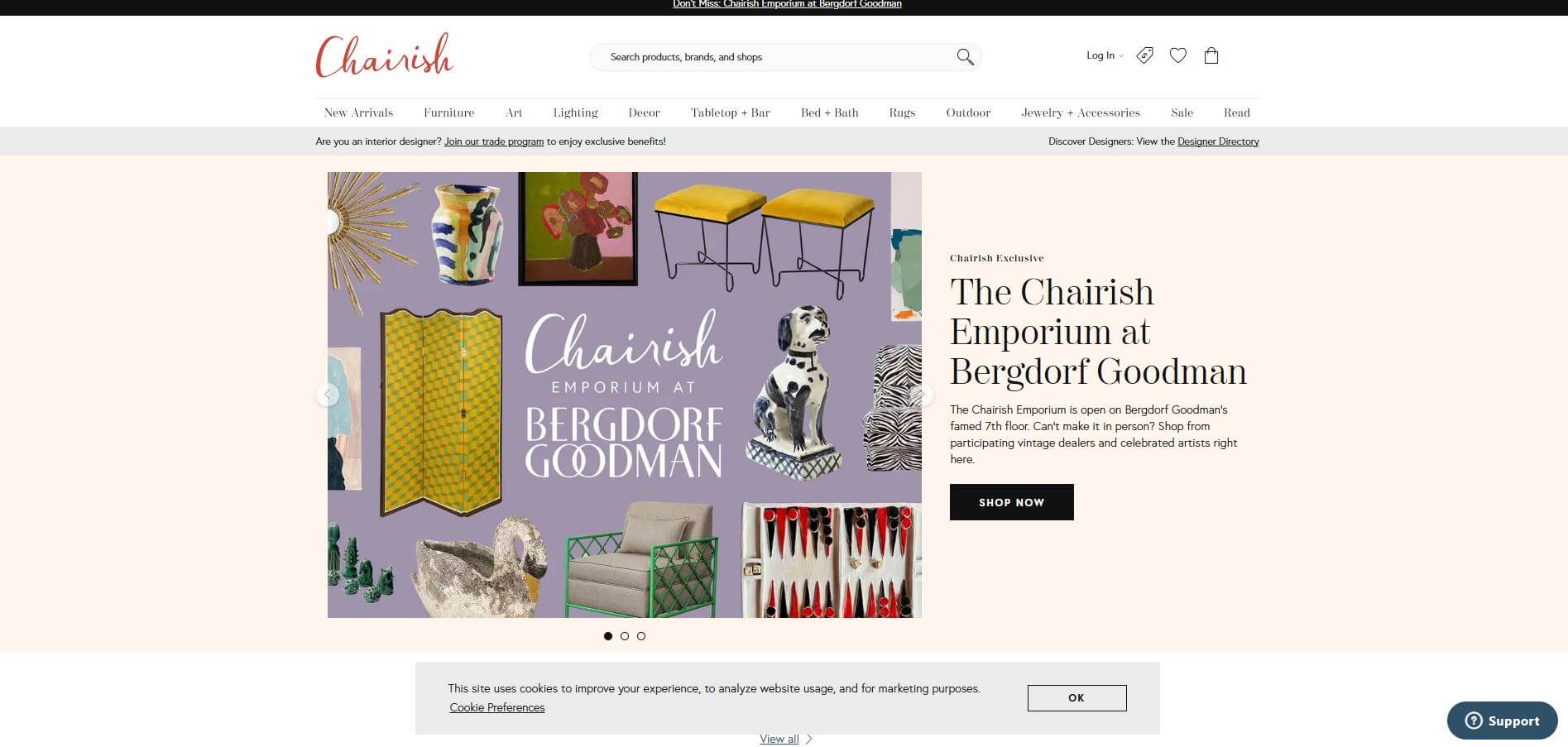
Evergreen niches like home decor and furniture deserve their spot on our list, too.
Chairish is a consignment shop dedicated to selling high-quality items you can for your home. The platform has curators that go through every listing posted to make sure they pass the minimum quality standards.
These curators also improve your product photos and take care of the final upload for you.
You won’t have to worry about shipping, too, since all of that will be handled by the company. All you need to think about is making sure your items pass their standards.
Platform Fees
Free to list, but Chairish takes a commission of 20% to 30% per sale. The Elite plan costs $149/month and includes business analytics, prioritized customer service, and faster payments.
Best For
Sellers of curated, high-end furniture and home decor looking for a quality-focused marketplace.
15) Rakuten

Established in 1997, Rakuten is a Japan-based marketplace that offers a handful of benefits to customers. Cashback, deals, shopping rewards—you name it.
Although it’s based in Asia, according to their website, they have 20 million+ users located in the United States. And these users have already enjoyed more than $3.2 billion worth of cashback from the website.
Major partners for cashback include Kohl’s, Levi’s, LifeLock, Macy’s, Neiman Marcus, and Nike. The number definitely feels exaggerated but at least that’s what they say.
50,000 merchants conduct business on the platform, but they’re all either registered in the United States or Japan as this is a requirement. These merchants also needed approval before they were able to list their items.
If you’re not a resident in either country, you need to look for a service partner and course your application through them.
Platform Fees
- Starter Plan: Free, with a variable commission fee starting at 16% (excl. VAT).
- Expert Plan: €49/month (excl. VAT), with a variable commission fee starting at 10% (excl. VAT).
Best For
Established businesses in the U.S. or Japan looking for a rewards-driven marketplace with a loyal customer base.
16) Sellfy
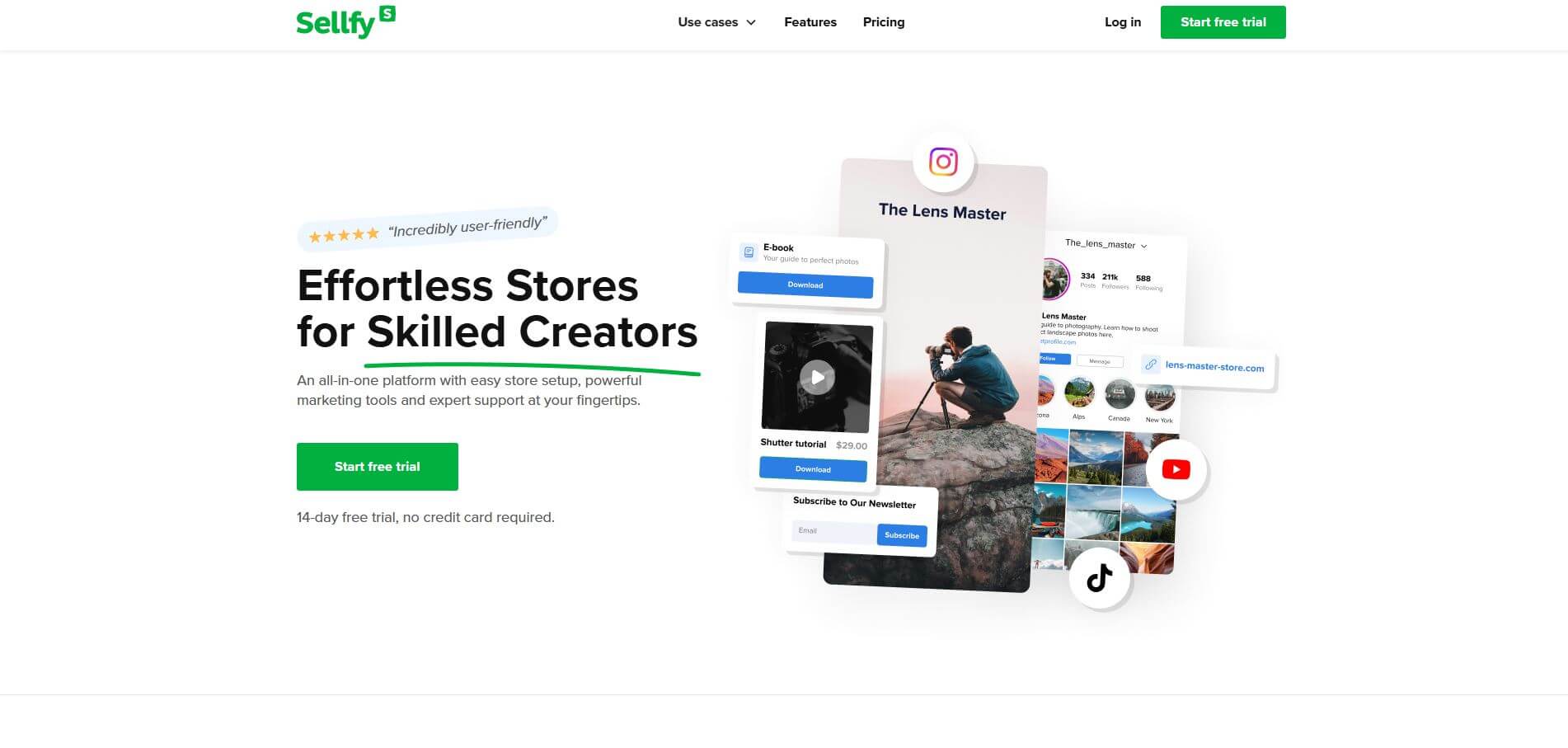
Sellfy is an online marketplace that connects creators of digital goods to buyers. Here, you’ll mostly find ebooks, digital art, music, comics, videos, and just about anything printable.
With more than 270,000 creators, buyers gain access to more than 1.2 million products.
As a seller or creator, you can easily create your own digital store on the platform. Payment processing, product hosting, and automatic download emails will be handled by Sellfy.
All you need to do is post as many design assets as you can.
If you already have your own website, Facebook page, or YouTube channel, simply use Sellfy’s embed buttons to make your products easier to purchase.
Apart from these features, the platform also makes it convenient for sellers to create their email marketing campaigns to increase the chances of sales.
Platform Fees
- Starter Plan: $22/month, supports up to $10,000 in sales with unlimited products.
- Business Plan: $59/month, allows up to $50,000 in sales, includes product migration, 10,000 email credits, and removes Sellfy branding.
- Premium Plan: $119/month, designed for sellers earning $200,000+ per year, with 50,000 email credits, priority support, and product migration.
- 14-day free trial available.
Best For
Digital creators looking for an all-in-one storefront with easy product hosting and built-in marketing tools.
17) Poshmark
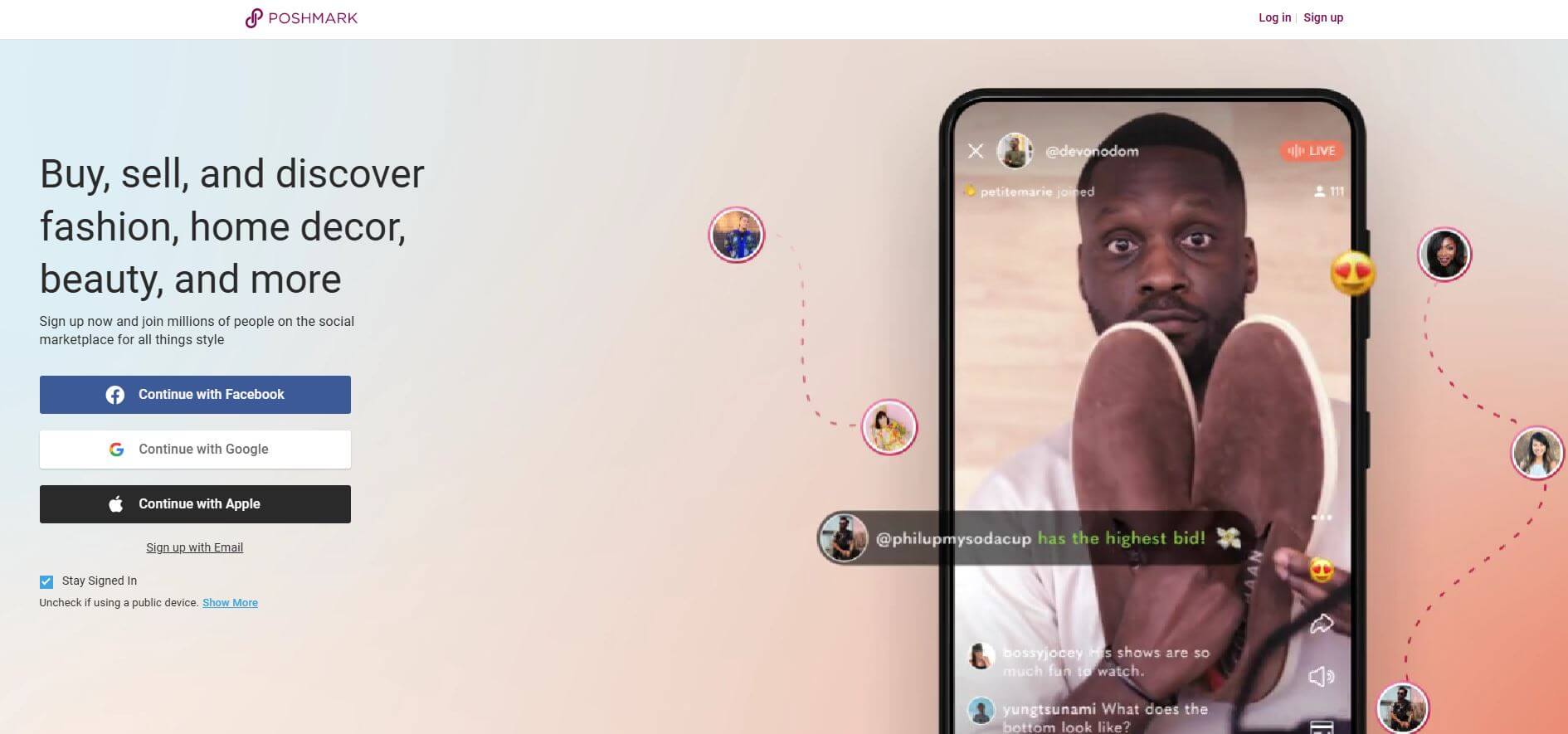
Looking for a website dedicated to clothing items? Poshmark definitely fits that bill. In fact, it’s one of the most luxurious marketplaces for clothing on the internet.
Poshmark was established in 2011 to sell only clothing items for men, women, kids, and pets. Its target markets are North America and Australia.
Sellers can leverage features like Posh Stories to showcase products through photos and videos, as well as listing tagging to improve product discoverability.
Inventory management and sales reports further streamline the selling process.
Platform Fees
- No listing fees.
- Flat fee of $2 for items under $15.
Best For
Fashion-focused sellers looking to tap into an engaged community and a social-driven shopping experience.
18) Flipkart
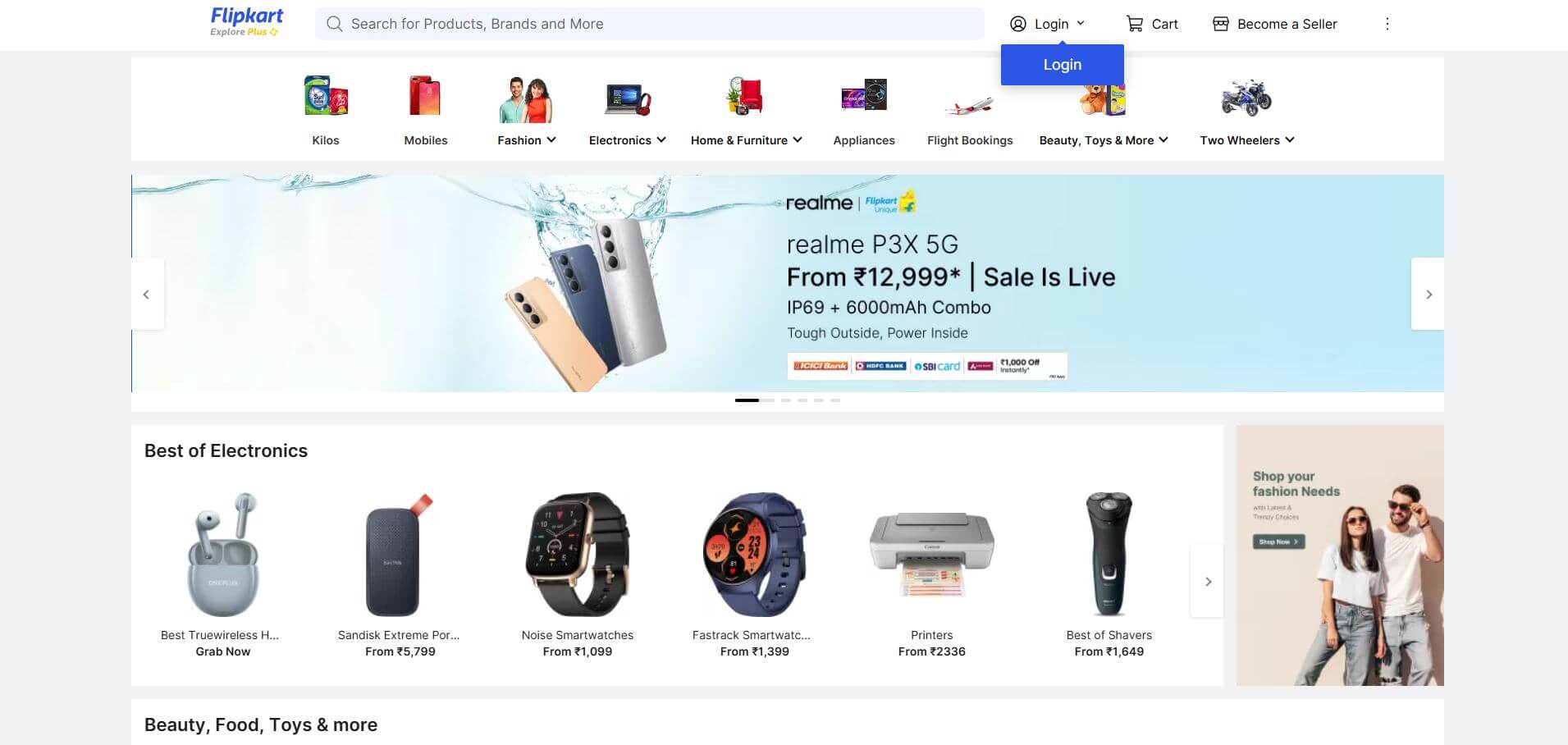
In 2007, Flipkart was founded as an online bookstore. Seeing the opportunity in the virtual space, it expanded to selling fashion, home essentials, groceries, and other lifestyle products.
The company is based in India, but it’s considered to be one of Amazon’s top competitors, being a close second. In 2018, this Indian ecommerce giant was acquired by Walmart for $16 billion.
Don’t get us wrong, though. This marketplace would also be an ideal site to market your products to customers based in India.
Platform Fees
Flipkart charges multiple fees, which can significantly impact profit margins. These include:
- Commission Fee – Varies based on order value and product category.
- Shipping Fee – Depends on product weight and delivery location.
- Collection Fee – Based on payment method and order value.
- Fixed Fee – Determined by the order item value.
- GST (Goods and Services Tax) – Applicable as per Indian tax regulations.
Best For
Sellers looking to enter the Indian eCommerce market, especially in high-demand categories like fashion, electronics, and home essentials.
4 Benefits of Selling Products Online
24/7 Store Hours
You’re always open for business.
Everyone can freely browse through your store at any time of the day. You also get to cater to people living in different time zones.
No need to worry about manning the store when you have bots to do that for you. You won’t have to consider drastic increases in costs since everything’s online.
Scalability
Let’s be honest, entrepreneurs think ahead. These people start a business, hoping it succeeds and grows exponentially. The internet can make this happen if you take the right steps.
When you find the right platforms to track sales and conduct thorough product research, you can scale your business in no time.
Depending on your business model, you probably won’t need a lot of inventory to add more products to your catalog.
Cheaper Costs
The costs to start and maintain an online store are much more affordable compared to starting a physical store.
First of all, the “rent” for online stores is much cheaper. As an example, you can already have a good online store on Shopify for as low as $19 per month. That alone puts you in better financial standing as local rental prices don’t go anywhere below $50.
Another set of costs you don’t need to include in your monthly budget is utilities. Unless you decide to put up your own office, you only have to worry about this month’s internet bills.
Normally, these costs take a huge chunk of your monthly profit from physical store sales. With an online store, you get to redirect these into more meaningful expenses—like marketing.
Flexible Location
One major reason many ventured into online selling is the flexibility to sell wherever you want. Though some countries have restrictions, you’re generally free to start and manage your store remotely.
You don’t have to worry about foot traffic or prime spots. You simply need to focus on marketing your shop well.
We have to say, it does feel good to work while overlooking mountains, or hearing waves crash.
FAQs about Online Selling Sites
How to Select an Online Selling Site?
Each online marketplace or selling site has its advantages and disadvantages.
You shouldn’t just go for the most popular one, without considering the following factors:
- Features
- Subscription fees
- Target audience
- Niche
First, consider the features of the platform. Are these features compatible with your business?
Explore how you can maximize each aspect for the benefit of your business. That way, you get to enjoy your monthly subscription plan—if you even pay for one.
Another factor to consider is the subscription fee. If you want to save up on costs, opt for free or more affordable platforms. If you have room in your budget, don’t be shy to try out premium platforms.
Your target audience should also have a bearing on your chosen platform. International target markets mean that you sell on global platforms such as Amazon and eBay. Going local means you opt for Facebook Marketplace or Nextdoor.
Lastly, your niche plays a key part in your decision process. These platforms already have established niches. You wouldn’t want to sell electronics on Etsy, nor do you want to sell jewelry on Sellfy.
What Are Essential Details for Online Selling?
Over the years, online sellers found key factors that contributed to their internet success.
In no particular order, keep the following factors in mind:
- Effective Advertising
- Optimized Product Content
- Fast Shipping
- Reliable Order tracking
There’s a thin line between traditional advertising and effective advertising. The former is a requirement, while the latter requires thorough research.
Do your research and use appropriate strategies to reach your target market.
Optimized product content also goes a long way when it comes to sales. Know the right keywords to use, and sprinkle your website with these accordingly. You’ll see and feel the effects in no time.
With effective advertising and optimized product content, expect an increase in sales. But before that happens, ensure your customers get to enjoy fast shipping.
41% of customers don’t mind spending more on express shipping. So take advantage of this. The faster their orders arrive, the more they are willing to pay premium prices.
And, of course, pair your speedy shipping with a reliable order tracking system. People want updates about their orders, so indulge them.
All these should package your store as a reliable and quality online business.
Which Online Marketplace Is the Cheapest?
The cheapest online marketplace is Facebook Marketplace. It’s completely free to use.
Forget about services fees, transaction fees, listing fees, and all the other fees you can think of. On top of that, all payments are handled between buyers and sellers.
As mentioned, you only need to create a Facebook account to start selling. Listing your items is also a breeze to do.
Final Thoughts
Surely, you now have an answer to whether or not you’re ready to shift to an online store. The list of online selling sites above gives you an idea of where you can sell your products to reach the right target market.
We’ve also listed down important points to help you select the right platform and take note of what you need to succeed in your line of business.
Starting an online store can be a challenging task. Don’t worry NicheDropshipping is here to help, give us a call to see how our agents can assist you.
From finding the right suppliers to sourcing quality products and fulfilling your orders we’ve got you covered through every step of your ecommerce journey.
